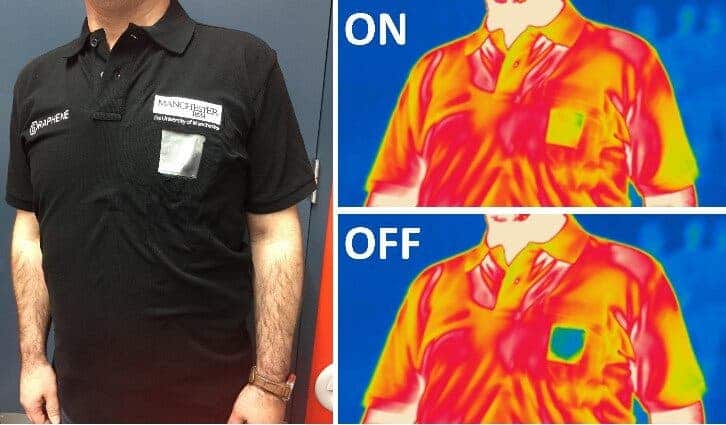Researchers have implemented the 2D material graphene into smart textiles that can adapt to lower your temperature in hot climates.

When it gets hot, our bodies radiate energy in the form of electromagnetic waves. We can’t see this with the naked eye since it’s in the infrared spectrum (called blackbody radiation). If you want to radiate heat, it’s best to take advantage of the full infrared radiation spectrum, to lower our temperature as much as possible. Conversely, if you’d want to keep the body hot, you’d use something that blocks as much energy as possible.
Emergency blankets — also called space blankets, thermal blankets, or Mylar blankets — are a good example on this: on one side, they trap infrared energy and keep the wearer warm and on the other side, they release energy (although it doesn’t make sense to keep the blanket on you if you want to cool down, because you’d just trap your own heat, and the negative would outweigh the positives).
But regardless of a material’s reflectivity properties, they’re fixed and unchangeable. At least, this was the case until now.
Scientists at Manchester’s National Graphene Institute have developed smart textiles that can change states dynamically, keeping you warmer or cooling you down based on your temperature needs. Professor Coskun Kocabas, who led the research, said:
“Ability to control the thermal radiation is a key necessity for several critical applications such as temperature management of the body in excessive temperature climates. Thermal blankets are a common example used for this purpose. However, maintaining these functionalities as the surroundings heats up or cools down has been an outstanding challenge.”
The technology opens up a world of possibilities, from architecture and space suits to the textile industry. Researchers had previously been able to use graphene for thermal camouflage, fooling infrared cameras. But being able to change from one state to the other dynamically is a completely different beast. The graphene structure can also be embedded into a number of different textile materials, including elastane and cotton.
“We believe that our results are timely showing the possibility of turning the exceptional optical properties of graphene into novel enabling technologies. The demonstrated capabilities cannot be achieved with conventional materials.”
However, while having innovative cooling T-shirts is exciting in itself, researchers have their eyes on a bigger prize: satellites.
“The next step for this area of research is to address the need for dynamic thermal management of earth-orbiting satellites. Satellites in orbit experience excesses of temperature, when they face the sun and they freeze in the earth’s shadow. Our technology could enable dynamic thermal management of satellites by controlling the thermal radiation and regulate the satellite temperature on demand.” concludes Kocabas.
Journal Reference: M. Said Ergoktas et al. Graphene-Enabled Adaptive Infrared Textiles, Nano Letters (2020). DOI: 10.1021/acs.nanolett.0c01694


